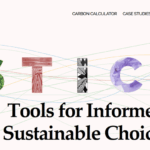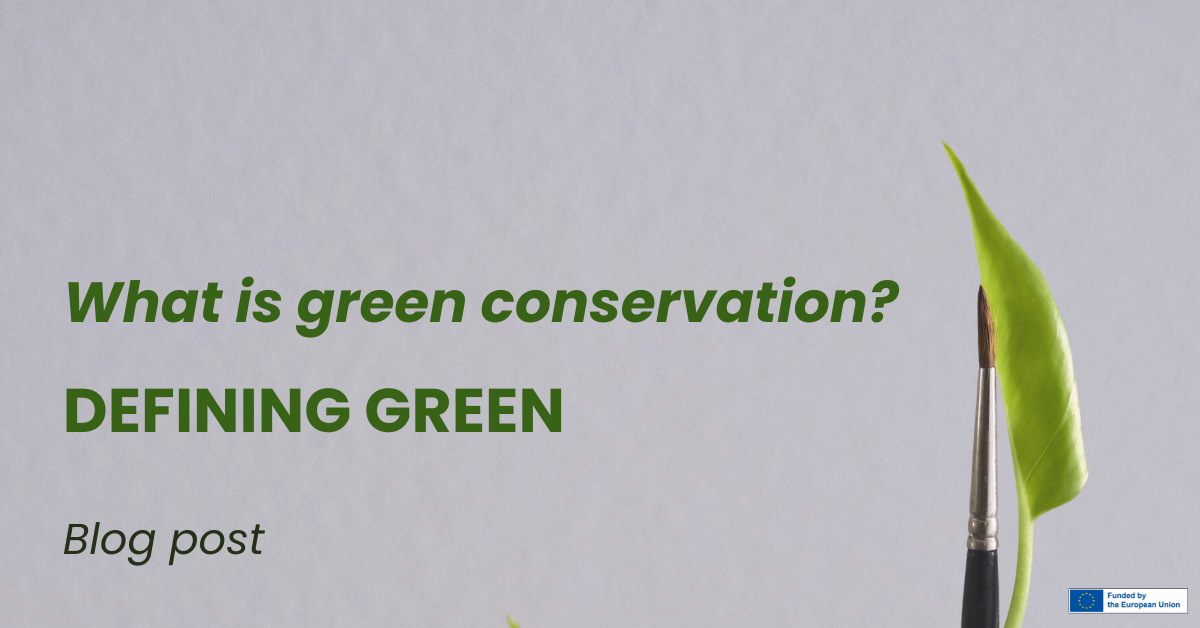
Updated STiCH Carbon Calculator Launch – live web event
July 17, 2025
Green Conservation
August 23, 2025By Caitlin Southwick (UvA)
Co-Authors: Julia Wagner (RMA), Gwendoline Fife (RMA)
Introduction
In 2019, I sat in the convention hall in Kyoto, Japan during the ICOM (International Council of Museums) triennial conference. This historic building was also the place where the Kyoto Protocol had been signed in 1997 – a revolutionary step in the climate change conversation. And where ICOM was about to make history.
The topic on everyone’s mind was the museum definition. The three-year long process had finally culminated in a vote – would it pass? These seemingly simple questions brought on a wave of other issues – what was the process behind creating the definition? Who was involved? Who was excluded? What would the implications be? And why were these three little sentences causing such a stir?
It was astounding to realize just how much impact these words would have. Many countries and governments use the ICOM museum definition – enabling not only the prestigious label but funding opportunities and certain legal rights. The definition was not just about getting clarity on what a museum should or could do but it was what would make or break many institutions globally.
The debacle that followed was eye-opening. Not only to realize how significant this was but also how important the process was. And how complex. Coming to a consensus as a sector is challenging – not only because there are so many people with so many differing experiences and points of view, but also because it is very challenging to get everyone to voice those opinions (especially within a specified time constraint).
But having that consensus is invaluable. Providing a reference point, using a democratic process, and ensuring that the process is inclusive will ensure ownership and therefore acceptance. This is a concept that is often discussed in sustainability, and here it was, so tangibly, in the museum world too.
Definitions
While we say that actions speak louder than words, words are often the instigation for action. Definitions are words with meaning. They unite us in a common understanding around our work and our purpose and they help guide us in specific directions. As a member of the Working Group on Sustainability for ICOM, I had a front row seat to the process and worked tirelessly with my colleagues to get the word ‘sustainability’ into the definition. Which did pass finally in 2022 (ICOM Museum Definition).
We talk about a museum as an abstract entity with a real space – but by defining it we give it meaning. We give it purpose. We give ourselves a guiding light to follow. Now at GoGreen, we are doing the same with the term “green”.
“Green”
As conservators, we inherently care about preservation. Our life‘s work is about prolonging life and ensuring that future generations can continue to carry and treasure the historic and defining human aspect of our species. Our culture.
However the current practices of the conservation field are taking only one type of preservation into account – that of the object. Far too many of my friends have experienced sometimes deadly repercussions from the harmful chemicals we use – far too much waste is produced – far too much energy consumed. Our practice – while preservation minded – is not preservationally holistic in practice.
So how can we do better? We have heard of “green conservation” – ideas that take into account holistic preservation. We dream of a green conservation practice – one that is non-toxic, has no carbon footprint or negative environmental impact, one that is safe for people and the planet, and yet upholds the professional standards of our practice. But what does this look like? What does it mean?
Green conservation is an ideal – one that is safe for the object – safe for us – and respectful of the planet. But how does this happen? What does this look like and what does it mean? We can talk about “green” but what considerations do we need to take into account?
Green is a word that’s thrown around a lot – it has resulted in massive backlash in many industries. People are often accused of greenwashing – making false claims to maliciously manipulate customers into buying things by making them think that they’re doing a good thing for the planet. This greenwashing has a long history and will no longer be tolerated. Last year, the European Commission proposed legislation – the Green Claims Directive – which outlines new rules on what can be called green and why. This important piece of legislation is the first step on a long road to getting clarity around what the impacts of our actions and our purchases on the planet but also what “green” actually means.
“Green Conservation”
So what does green mean for conservation? Why does it matter? Why do we need a definition?
To be able to unite as a sector and get clarity on what green is will not only enable us to understand the implications of what we do – but it will enable us to strive for better. To know what considerations need to be taken into account for our work and to think holistically about the impacts of the choices we make.
As conservators we all care – and as conservators we must unite around a common understanding of what green conservation is so that we can work together to achieve green or more environmentally responsible, more respectful and more object-friendly practices.
By coming to a consensus as a field we will not only be able to make better decisions ourselves but we will be able to advocate for greener materials and options from our vendors and suppliers – our packing and shipping companies – and our colleagues. Labeling something as “green” may or may not be possible considering the complexities of the field – but having an understanding of what we need to take into consideration and having an understanding of what needs to be our priorities will enable us to make greener choices and work together towards a greener future.
GoGreen Definition
The GoGreen project has been working on creating a consensual definition of green for the field. The process, outlined in detail on our website here, was inspired by the ICOM Museum Definition as well as other fields and has been workshopped globally to get as much input from as many stakeholders as possible. The results will be used to create consensus around policy and language within the field. The aim is to have endorsements of the definition from leading institutions and organizations globally to support alignment and clarity on what green is and how we can work toward it collectively.
Tools and Support
Green is not just a word, it’s an action. Green is often discussed, now defined, but what it looks like in practice is not always so clear. As part of the work in defining green and identifying how we can support its practical implementation, GoGreen created a survey to better understand how green conservation plays into the daily work of conservators globally. We wanted to understand not only how ‘green’ was perceived, but how it was being practiced. GoGreen aims to help conservators make greener decisions, and to better understand what would be helpful to conservators in this task, we asked a series of questions to understand if and what resources conservators are currently consulting to evaluate the environmental impact of their work. How often do they use these resources? What information are they looking for and what do they feel is missing? How can we help?
Results demonstrated that most conservators don’t use resources. 64% of responders consult existing resources never or 1 to 25% of times. However, when asked if they would consider consulting such a resource in the future 87% responded “yes” (the remaining 13% marked unsure). This shows the demand among the wider conservation community for more resources which provide insights into environmental impact evaluations. Many conservators felt uncertainty around existing resources, citing potential barriers such as general doubt in accuracy or a tendency to oversimplify information regarding the topic, as well as language barriers. The survey also showed the type of information that respondents are looking for or feel is currently lacking. Using this information, GoGreen was able to inform not only the green definition (specifically the green parameters), but the outputs of the project to better align with the needs of the field. Continued engagement with the wider conservation community through focus groups, an ongoing survey and expert panel feedback has provided a transparent and democratic process for defining green, and ensuring that all aspects of the project are founded in conservation needs and the definition specifically is rooted in consensus, clarity and relevance for conservation work.
Conclusion
We have seen how impactful words on a page can be. A single definition has the power to shape policy, shift funding, and unite communities. And we have seen the demand and need for greener conservation practices and practical resources to guide us in that direction.
A clear and widely supported definition of what it means to be “green” in conservation is a foundational step toward real change. It empowers professionals to make informed, values-driven decisions. It supports manufacturers and suppliers in aligning their products with sustainability goals. And it lays the groundwork for future research, innovation, and policy.
By definition:
Green conservation is a sustainable approach that involves holistic, balanced decision-making to reduce health, climate and environmental hazards while adhering to professional ethics.
Green conservation aspires to protect cultural heritage while minimizing harmful impacts on climate, human health, environment and resources.
By gaining clarity, we can successfully take the next steps toward our dream of an environmentally responsible, healthy, and sustainable conservation field. Being green means honoring our responsibility to the objects we protect, the people who work with them, and the planet that sustains us all. It’s about broadening our idea of preservation to include not just cultural heritage, but environmental and human health. Our hope is that with this shared understanding, we can move forward.
Let’s define our future – together.
We invite you and your colleagues to join us in this journey!
Find out more about the GoGreen Definition of Green here and give us your feedback and input in our Green Definition Survey here! Have questions or want to get in touch? Reach out to us at info-gogreen@uva.nl.

